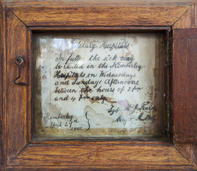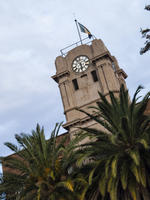Outbreak of the South African War
By the end of 1898, enrolment at St Patrick’s College had reached 108 and necessitated another classroom being added the following year. Any further improvements and additions were halted, however, by the outbreak of the South African War, which had a near-disastrous effect on the infant school.

The Siege of Kimberley, begun in October 1899, marked a time of real privation for the town. For the schoolboys, however, it was a time to remember.
Recalled one Hector Lucas, 'The schools were closed as soon as the siege started and we boys had the time of our lives... We would lie flat when we heard the scream of a shell, and when it burst, rush off to collect the hot pieces... People took little notice of the shelling and surprisingly few were hit, though a good deal of damage was done to buildings....' (School magazine.)
The siege was lifted in February of the next year, following which the commandeered the school buildings for use as a hospital. For classes to continue, two marquees were erected. Although functional, they were deemed to be 'most inconvenient for school purposes'. (Famous Schools.)
When the war shifted eastwards C.B.C. picked up where it had left off. In 1901 a new wing with several more classrooms was built, and the school took its colours of green, navy and yellow.
Outstanding examination results in the same year added to the school's growing reputation: of the 11 matric entrants all passed, 10 of them in the first class. The effect on the enrolment was dramatic. Numbers had risen to 252 by the end of the year, increasing the demand for boarding facilities and resulting in the further extension of the building.
Construction of Additional Buildings

During this golden era of sport, the school also reigned supreme in soccer, winning the Finlayson Cup 12 years in succession. However, most schools switched to rugby after the First World War and C.B.C., rapidly running out of schools with which to compete on the soccer field, had no choice but to follow suit. The first tennis court was built in 1912 and two more in 1914.
Despite the war, a further block of six classrooms and an up-to-date chemistry block were added to the school buildings in 1918. By 1922, the year in which the Old Boys' Union was formed, enrolment was over 500, including 140 borders. Two years later the need for accommodation was satisfied with the construction of additional classrooms and boarding houses.
Successes and Setbacks

The year 1928 proved a record year for sporting activities. Ten trophies were won, four in rugby, with the team sweeping clean, and five in shooting competitions. The plans for the new chapel were also completed in this year. Designed in Romanesque style by Dublin architect GI O'Connor, it was opened on St Patrick's Day in 1932. In 1933 the War Memorial Tower with its chiming clock and a memorial plaque to the fallen of the First World War was completed. Although the original Neoclassical-style facade of the school has since been altered out of all recognition, the tower itself has survived intact.
In 1937, the college suffered a setback in the form of a fire that gutted a music room and a workshop, and the school also lost a friend and loyal servant when Brother Mullan died of a heart attack. This run of ill fortune extended into 1939 with the outbreak of the Second World War. Nearly 1 000 Old Boys signed up; 70 gave their lives and 41 decorations for bravery were won. A lasting tribute to the school's dead heroes, a Memorial Swimming Pool, incorporating the names of the fallen, was paid for by the old Boys' Union in 1947. Old Boy Colonel JS Williams, DSO, DFC and Bar, performed the presentation.
It was not until 1945 that the house system - so fundamental to the English-tradition schools - was introduced. The houses are named after noteworthy benefactors of the college: Michaelis, Cavanagh, Spiers and Keeley.
CBC Becomes Fully Integrated

Christian Brothers' College is nothing if not a reflection of the society in which it has grown up, a mirror of the changing social norms, religious beliefs and economic situations of the times. At no time in its history has this been more true than now. In 1977 the school was permitted by government decree to admit 'non-white' applicants up to a maximum of 10 percent of enrolment. Ten years later this restriction was lifted, and today the school is fully integrated.
The economic pinch began to hurt in 1969 when C.B.C. in Pretoria opened its boarding hostel, luring away pupils who found it more convenient to travel to Pretoria than to Kimberley for their schooling. In 1981, there were 150 boarders at C.B.C. in Kimberley, but by 1988 the numbers had fallen to only 70. In 1986 the school opened its doors to both girls and boys, embracing a coeducational status.
Other changes, less radical and more gradual, have been the drop in the proportion of Catholics to non-Catholics; the steady decrease in the number of Brothers teaching at the school, from a peak of 22 in the 1950s to only three; and, most recently, the appointment of the first lay headmaster. Mr Leon Woeke Benade, BA Ed, MEd, came to C.B.C. at the start of 1992 from St David's Marist Brothers' College in Inanda, Johannesburg, where he had been deputy headmaster. His appointment opens a new chapter in the life of Christian Brothers' College, Kimberley. What Benade can depend on is that the traditions of excellence and strong moral precepts that have been developed and maintained over nearly 100 years at the school will continue. The ethos of the school, aptly expressed in its motto, will ensure that C.B.C. will negotiate successfully the times of change that lie ahead.